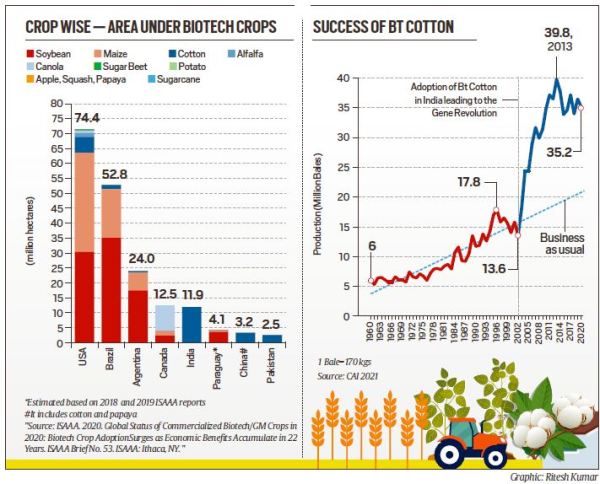GM Mustard
Context
- Dhara Mustard Hybrid-11 (DMH-11) had recently been approved by the Genetic Engineering Appraisal Committee (GEAC) for cultivation in farmer fields, as a precursor to commercial cultivation.
What is GM Crop?
- A genetically modified organism (GMO) or living modified organism (LMO), is any organism whose genetic material has been modified using laboratory-based transfer of genetic material from another organism.
- GM crops are derived from plants whose genes are artificially modified, generally by inserting genetic material from another organism, to give it new properties, such as improved nutritional value, increased yield, resistance to disease or drought, etc.
Regulations
- In India, Genetically modified organisms and products are regulated by the Ministry of Environment, Forest and Climate Change (MoEFCC) under the provisions of the Environment (Protection) Act, 1986.
- Genetic Engineering Appraisal Committee under MoEFCC is authorised to review, monitor and approve, import, export, transport, manufacture, use or sale of GMO.
- The Food Safety and Standards Act 2006 prohibits import, manufacture, use or sale of GM food without the approval of the Food Safety and Standards Authority of India (FSSAI).
- So far, commercial release is granted only for Bt cotton. Recently, the GEAC has given approval for the commercial cultivation of GM Mustard.
- It should be noted that the GEAC’s approval does not mean commercial cultivation, the final decision to allow commercial cultivation is taken by the MoEFCC.
Dhara Mustard Hybrid-11
- It is an indigneously developed transgenic mustard which is a genetically modified variant of herbicide tolerant (HT) Mustard.
- It contains genes such as ‘barnase’ and ‘barstar’ isolated from soil bacterium, Bacillus amyloliquefaciens.
- It has been developed by the Centre for Genetic Manipulation of Crop Plants (CGMCP) at Delhi University.
Need for DMH – 11
- As mustard crop accounts for 40 percent of the total oilseed production in India, GM mustard would make India self-reliant in oil production.
- India produces only 8.5-9 million tonnes (MT) of edible oil annually while it imports 14-14.5 MT, thus GM mustard would also result in huge savings of foreign exchange reserves.
- At present, mustard is grown in 8 million hectares, with the average yield of 1-1.3 tonnes per hectare. It is said that GM mustard could potentially raise the yields to 3-3.5 tonnes per hectare.
- They are also resistant to pests that cause white rust, a common disease of mustard, and thereby significantly improve yield while reducing farm inputs.
Concerns
- Details of the trial and its outcome on food safety have not been made public before sanctioning its introduction.
- There is also an apprehension that the seeds of this crop cannot be used for regeneration. Hence, the farmers need to buy new seeds every time they want to grow the crops.
- Today, mustard is a primary natural crop that bee farmers depend on. Hybrid mustard crops can result in fewer flowering days, reducing honey harvesting season and affecting bee population and honey bee production.
- Besides, through pollination, honeybees could transfer the genes of GM mustard to other plants. This may lead to horizontal and undesirable gene transfer among plants, affecting the biodiversity and causing the growth of unwanted and invasive weeds.
Need for adoption of GM crops
-
- Scientific innovations like GM Crops has to be adopted to meet the current challenges as given below:
- Over-exploitation of natural resources (soil, water, biodiversity);
- Scientific innovations like GM Crops has to be adopted to meet the current challenges as given below:
- Declining farm productivity;
-
- Urgency to achieve sustainable development goals, especially ending poverty and hunger, and
- Addressing timely the adverse effects of climate change.
- By not allowing GM crops, one is denying the basic rights of farmers who want to increase their incomes.
- It is scientifically proven that the consumption of refined GM oil does not allow any protein to enter the human system and hence is completely safe from a health point of view.
World Scenario
- Genetically modified maize, soybean, cotton, tomato and canola are grown across the world. More than 70 countries have accepted the use of GM crops.

India’s History of GM crop adoption
- First GM crop, Bt cotton, was adopted in 2002 in India. India had witnessed remarkable changes after its adoption as below:
- Cotton production witnessed an increase of 192 per cent in just 12 years.
- Cotton productivity increased from 302 kg per hectare in 2002-03 to 566 kg per hectare in 2013-14, an increase of 76 per cent.
- Area under cotton cultivation expanded by 56 per cent, of which about 95 per cent is under Bt cotton.
- The income of cotton farmers increased significantly.
- It made India the second-largest producer after China, and the second-largest exporter after the US, of cotton in the world today.
Issues associated with GM crops
- The success of Bt cotton holds many lessons for policymakers but several concerns have been expressed by NGOs, civil society groups and farmers’ groups from time to time to emphasize the risks associated with GM crops.
- Some of these include
- enhanced sucking pest damage in Bt cotton;
- increase in secondary pests such as mired bugs and Spodoptera;
- emergence of pest resistance;
- environmental and health implications in terms of toxicity and allergenicity that can cause hematotoxin reactions in the human body and
- farmers’ exposure to a greater risk of monopoly in the seed business.
Way Forward
- Effective monitoring and surveillance is needed to ensure that safety protocols are followed strictly, to prevent the spread of illegal GM crops.
- Further, Environmental Impact Assessment should be carried out by independent environmentalists, research bodies, civil society organisations before the introduction.
reference:
https://agricultureandfoodsecurity.biomedcentral.com/articles/10.1186/2048-7010-1-14
Subscribe
Login
0 Comments
